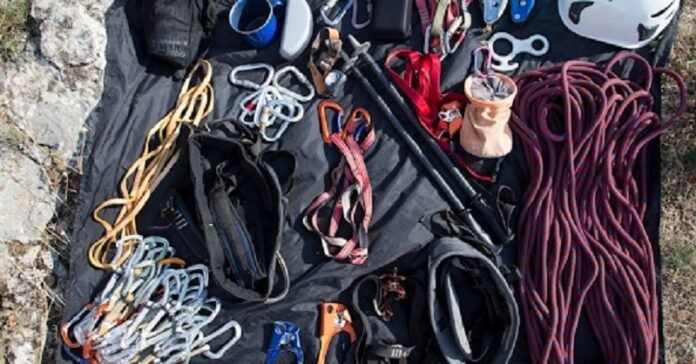Climbing mountains is a fantastic activity that may significantly improve your life. However, figuring out what you need to get started can be challenging.
To help you prepare for your mountain ascent, I have included a list of all the gear you will need.
So, what do you need to climb a mountain?
When packing for a mountain excursion, don’t forget these essentials:
- Suitable footwear
- Equipment for Navigation and Hiking (Poles, Backpack, Clothing, Food, and Water)
- A flashlight for the head
- Tools for Emergencies
Every time I climb a mountain, no matter how long or tough it is, I always pack all of the things stated above.
They aid in keeping me secure and cozy and guarantee that I will return to my automobile without incident.
You can also carry camping equipment (depending on the length of your trip) or professional climbing equipment (based on the difficulty of the mountain) in addition to the items listed above.
Checklist for Mounting Climbing Equipment
As a hiker, climber, and scrambler, it would be my pleasure to help my other climber friends plan their first mountain tracking.
My exhaustive list of essential equipment for reaching the peak is as follows:
Essential Gear
- Hiking shoes
- Backpack
- Hiking poles
- Suitable clothing
- Water and food
- Navigation tool
- Headlamp
- Emergency supplies
This is the standard set of items I take with me whenever I travel. In fact, I always leave the house with this equipment.
Unfortunately, I learned this the hard way when I attempted a peak without any of the gear mentioned above and had to be airlifted off the mountain by helicopter.
Non-Essential Gear
- Camera
- Rain gear
- Water filtration device
- Stove
- Camping Supplies
- Knife
- Water Shoes
You may bring any of the following tools with you. That decision will be up to you and how challenging the mountain you’re climbing is.
Rock Climbing Gear
- Rope
- Harness
- Belay device
- Quickdraws
- Protection
- Climbing Shoes
- Cordelette
Rock climbing is a specialized technique used to scale vertical rock walls, such as those found on certain mountains. You need to have the proper equipment with you in order to do this task properly.
Alpinism Climbing Gear
- Ice ax
- Crampons
- Mountaineering Boots
- Snow and Ice Anchors
- Avalanche Gear
When ice and snow are present, mountaineering is known as alpinism. You’ll need certain tools to negotiate these hazards with any degree of safety. Only those who are properly equipped and experienced should attempt to scale the heights of the Himalayas.
So, I’ve divided all of my stuff into those four categories. As I said before, the kind of mountain you’re climbing will determine which bucket is most appropriate.
To give you an idea, just over a week ago, a buddy and I hiked to the peak of a nearby mountain to see the dawn. Since the ascent was very easy and did not need any technical skills, I just brought along my photographic equipment.
However, if I’m climbing a mountain in a more remote area, I’ll pack my camping essentials so that I may spend the night there.
Sometimes, I want a hot supper. Even if I’m not staying the night, I’ll carry my stove along. What I bring for a climb depends on the mountain in question.
I recommend consulting tourist guides and trip reviews to help you choose what gear is essential for your adventure.
In the case of an easy ascent, you may need to bring the ‘basic’ items. But if it’s longer or more complicated, you may want to check out additional gear!
What kind of mountain climbing do you plan on attempting?
The phrase “mountain climbing” covers a wide range of activities. It is helpful to examine the various forms of mountaineering prior to deciding what gear will be required. Each of them requires a unique set of climbing equipment.
Numerous sub-disciplines and styles of mountaineering exist. I shall group them according to the following general groups for your convenience.
Mountaineering
The activity of climbing to reach the peak of a mountain. Rock climbing, ice climbing, or both may be a part of the adventure.
Rock Climbing
This refers to the practice of climbing a vertical rock face using just your hands and feet. A trip to the top of a mountain is not required.
Ice Climbing
Climbing a vertical rock wall requires the use of both hands and feet. Not necessarily limited to reaching the peak of a mountain.
What do you need to climb a mountain?
Successful climbing requires both technical expertise and top-notch physical conditioning. You should make sure you have the proper equipment and apparel before embarking on your first climbing expedition.
Now that we’ve covered the gear and gained a basic understanding of mountain climbing, let’s talk about the important equipment – the things you need to carry with you each time you scale a mountain.
-
Hiking Shoes
The appropriate shoes are the most crucial equipment you can carry. Avoid painful blisters and weary feet by bringing appropriate footwear for long periods of walking.
For me, the best climbing shoes are those with medium-high ankle support. They’re tough enough for bushwhacking, soft enough that my feet don’t hurt, and supportive enough that I won’t twist my ankle if I trip. If my climbing peak involves tricky scrambling, I may swap to a set of approaching boots to improve my footing.
Scree and rough ground are common in the Rockies, where I climb, so sturdy footwear is essential. However, they may be excessive for many users.
Wearing boots significantly reduces your energy levels.
This is why many individuals switch to approach shoes, trail shoes, or hiking boots. These are simpler to walk in than boots because of their lower weight. They do double duty by reducing foot heat.
-
Crampons
Because of their strength and longevity, steel crampons are often used in general climbing. Compared to their steel counterparts, aluminum crampons are significantly easier to carry.
Aluminum crampons should suffice if the snow slopes you want to climb are not too steep. Steel crampons are advised, however, if your path crosses icy terrain or needs front pointing.
-
Hiking Sticks
Although I started off skeptical, I now consider hiking poles an integral part of my outdoor kit. I know they make me seem like a 60-year-old guy, but the help they provide is worth the blow to my pride.
There are two primary functions of a hiking pole:
- They’re essential for maintaining stability: The trekking poles serve as a third and a fourth point of balance, respectively, to keep you upright on treacherous inclines, tight hills, and river crossings. My poles have prevented several near-fatal falls for me.
- They reduce fatigue by Hiking poles, particularly on the way downhill, which may greatly increase your endurance. They have the added benefit of keeping your knees safe from harm.
Based on your hiking preference, you can carry one or two poles. On the other hand, the aluminum shaft is more costly less durable, but lighter. But wooden sticks are stable but cheap. Pick whatever suits you.
-
Backpack
A decent pack is the next most important piece of equipment for mountaineering after sturdy footwear. You’ll be wearing it for a maximum of twelve hours straight while toting around twenty pounds of accessories, so make sure it’s something you can relax in.
Suppose you want to avoid shoulder pain when hiking; a backpack with hip straps is a must-have. In addition to the waterproof cover and outside compartments, it also has a bag for your hydration pack.
My ideal volume for a mountaineering backpack is between 30 and 40 liters. A larger capacity (50 liters) is recommended for travels lasting more than a day, but a smaller 20-liter pack would suffice if speed is your primary concern.
-
Clothing
When mountaineering, it’s crucial to pack appropriately warm clothes. It will shield you against the sun and keep you from being too hot or cold, making you more at ease. Several types of clothing are distinguishable from one another:
Socks
Hikers almost always wear Merino wool socks. They serve to prevent blisters and stop feet from sweating.
One pro tip for finding the perfect pair of hiking shoes or boots is to try them on while wearing the socks you want to use on your hike.
Pants
Trousers are better than shorts since they prevent scratches and keep you warm if you need them. However, some people wear trousers that can be converted to shorts through a zipper.
Because they look silly and are unpleasant to wear, I cannot endorse them in any way. A heat stroke would be preferable to me wearing zip-off trousers.
I suggest investing in a high-quality pair of quick-drying, moisture-wicking trousers that don’t restrict your movement. However, DO NOT make any purchases that need waterproofing!
They will make you perspire excessively. Wear something light and airy, and avoid jeans at all costs. Jeans are cumbersome and rigid, and will keep their wetness for days if they become wet.
Torso
Mountaineering requires careful attention to layering. In my opinion, the following should be worn:
- Anything breathable or light, like a T-shirt.
- A lightweight sweater that will keep you warm enough to climb uphill in but will not weigh you down.
- Something warm to wear while you stop moving, such as a sweater or jacket. If you don’t have the cash for a nice down jacket, a good fleece can suffice in a pinch.
Head Gear
Keep your head down! I never leave home without my trusty hand, which does double duty by shielding my noggin from precipitation and the sun. If you want to protect your eyes, bring sunglasses.
-
Food & Water
One of the simplest ways to seriously hurt or die during mountain climbing is to run without water or food.
Last year, I went on an overnight adventure and ate all my food, and allow me to tell you, there are a couple of things worse than being stranded in the mountains without any food for 20 kilometers.
Completing your water supply is even more terrifying since your body can scarcely operate without it. You’ll need to take your food since most mountains won’t have restocking places.
I always make sure to bring the following:
- I’ll need 1 liter of water for every 2 hours that I walk (up to a maximum of 4 liters).
- If I need them, I always have six to eight extra protein bars on hand.
- The aim is to pack in excess so that you never have to worry about becoming hungry or thirsty.
-
Navigation Equipment
I recently had to be airlifted out of a dangerous part of the mountains after becoming lost and stranded there without any means of navigation, so I know firsthand how crucial it is to pack such tools.
Several things fit within this class, including but not limited to:
- Having a compass and a map is helpful, but it takes a lot of effort to learn how to use them properly.
- One’s current location may be shown on a global positioning system (GPS). And you can fill them up with routes and maps ahead of time so you can always find your way.
- Smartphones with navigational software like AllTrails are rapidly gaining popularity. Be wary of how quickly your battery will die, however.
You should never go mountaineering without any kind of navigational aid, such as a map or compass. It’s also a good idea to familiarize yourself with what to anticipate on the path by reading trip reports before setting out.
-
Headlamp
Even if you don’t think you’ll need it, carry a light if you are delayed and walk when it’s dark out.
A buddy and I were 4,000 feet down in the Grand Canyon a few years ago when we realized we’d forgotten our lights.
We found our way back to the vehicle by the moon’s light.
-
Ice Ax
Ice axes vary in length, weight, and form, so it’s important to consider your body type and intended use before purchasing.
Most mountaineers opt for an ax with a somewhat straight aluminum shaft, steelhead, and steel spike for ordinary mountaineering.
-
Ropes
You should bring a rope with you on your mountaineering adventure if you plan on tackling any glacier crossings or tough rock climbing.
Hiring a guiding service usually includes the use of ropes.
But if you’re picking out your personal strings for climbing, you should pay special attention to the weight since a lighter-weight rope is easier to lug around on a lengthy approach trek. The length and diameter of a rope are the primary factors in determining its mass.
Ropes with a smaller diameter are more easily handled since they weigh less. Thankfully, single ropes keep shrinking in diameter, and now you can buy one with a diameter of just approximately 8.5 millimeters.
The typical length of a climbing rope is 60 meters, however, for many alpine ascents, a shorter rope will suffice and will save you some weight. Consider how far away your climbing team members will be when they tie into the rope, as well as how much rope you’ll need in case of a rescue, to get an idea of how long a rope you’ll need.
-
Climbing Harness
Although a regular rock-climbing harness may be used for mountaineering, one made for the activity will provide superior comfort and ease of usage.
In order to make the harness small, light, and comfortable when carrying a pack, mountaineering-specific harnesses are often constructed from flattened webbing and have low-profile gear loops.
-
Emergency Supplies
Last but not least, when you go hiking in the mountains, you should always have a backpack with you that is stocked with emergency supplies. These are the kind of things that you keep in your emergency kit in the hopes that you won’t need them, but you know you’ll be glad you brought them just in case. The emergency beacon, extra batteries, and first aid kit are all included inside the emergency pack I take with me whenever I go into a remote area.
Conclusion
So, now you have an idea of what you need to climb a mountain. However, it is your responsibility to climb safely. So, consider your hiking track and other facts and make a checklist of stuff you should take.
Read Also: Is WcoStream A Legit Place to Watch Anime? Let’s Find out


































































